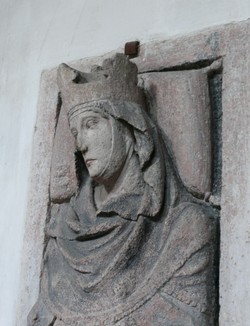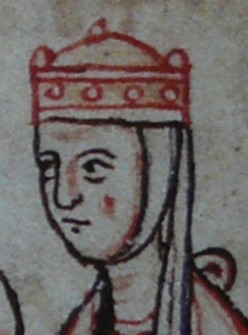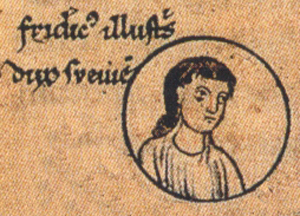|
Gertrude Of Comburg
Gertrude of Comburg (died 1130/1131) was the first queen consort of Conrad III of Germany. She was a daughter of Henry, Count of Rothenburg, and Gepa of Mergentheim. in Cawley, Charles, ''Medieval Lands: A prosopography of medieval European noble and royal families.'' Marriage Her marriage to Conrad III of Germany, Conrad of Swabia is estimated to have occurred c. 1115. Her new husband was the second son of Frederick I, Duke of Swabia and Agnes of Germany. He was a younger brother of Frederick II, Duke of Swabia. In 1115, Conrad was appointed Duke of Franconia by his maternal uncle Henry V, Holy Roman Emperor. Henry V died on 23 May 1125 and Conrad was an eligible candidate for the throne. However, Conrad supported his older brother Frederick II in the election for the new King of the Romans. The election was instead won by Lothair III, Holy Roman Emperor, Lothair III. Conrad and Frederick II had inherited the private lands of their decease ... [...More Info...] [...Related Items...] OR: [Wikipedia] [Google] [Baidu] |
Queen Consort Of Germany
German queen (german: Deutsche Königin) is the informal title used when referring to the wife of the king of the Kingdom of Germany. The official titles of the wives of German kings were Queen of the Germans and later Queen of the Romans ( la, Regina Romanorum, ''Königin der Römer''). Empress Maria Theresa (1745–1780) is often considered to be a ruler in her own right, as she was Queen regnant of Bohemia and Hungary, and despite her husband being elected as Holy Roman Emperor, it was she who ruled the Empire and continued to do so even after the death of her husband before ruling jointly with her son Emperor Joseph II. German (East Francian) Queens With the Treaty of Verdun in 843, the Carolingian Empire was divided. Lothair, the King of the middle Kingdom of Lotharingia or Burgundy, obtained the title of ''Emperor''; Louis obtained Eastern Francia, the area which would become Germany. The wives of that realm's Kings are thus German Queens (or more precisely, East Francian ... [...More Info...] [...Related Items...] OR: [Wikipedia] [Google] [Baidu] |
Iziaslav II Of Kiev
Iziaslav II Mstislavich ( uk, Ізяслав Мстиславич, russian: Изяслав II Мстиславич; c. 1096 at Izbornik – 13 November 1154), was the second son of Mstislav Vladimirovich () and . He was baptized as Panteleimon. Izyaslav is considered to be progenitor of the [...More Info...] [...Related Items...] OR: [Wikipedia] [Google] [Baidu] |
Hohenstaufen
The Hohenstaufen dynasty (, , ), also known as the Staufer, was a noble family of unclear origin that rose to rule the Duchy of Swabia from 1079, and to royal rule in the Holy Roman Empire during the Middle Ages from 1138 until 1254. The dynasty's most prominent rulers – Frederick I (1155), Henry VI (1191) and Frederick II (1220) – ascended the imperial throne and also reigned over Italy and Burgundy. The non-contemporary name of 'Hohenstaufen' is derived from the family's Hohenstaufen Castle on the Hohenstaufen mountain at the northern fringes of the Swabian Jura, near the town of Göppingen. Under Hohenstaufen rule, the Holy Roman Empire reached its greatest territorial extent from 1155 to 1268. Name The name Hohenstaufen was first used in the 14th century to distinguish the 'high' (''hohen'') conical hill named Staufen in the Swabian Jura (in the district of Göppingen) from the village of the same name in the valley below. The new name was only applied to the hill ... [...More Info...] [...Related Items...] OR: [Wikipedia] [Google] [Baidu] |
Year Of Death Uncertain
A year or annus is the orbital period of a planetary body, for example, the Earth, moving in its orbit around the Sun. Due to the Earth's axial tilt, the course of a year sees the passing of the seasons, marked by change in weather, the hours of daylight, and, consequently, vegetation and soil fertility. In temperate and subpolar regions around the planet, four seasons are generally recognized: spring, summer, autumn and winter. In tropical and subtropical regions, several geographical sectors do not present defined seasons; but in the seasonal tropics, the annual wet and dry seasons are recognized and tracked. A calendar year is an approximation of the number of days of the Earth's orbital period, as counted in a given calendar. The Gregorian calendar, or modern calendar, presents its calendar year to be either a common year of 365 days or a leap year of 366 days, as do the Julian calendars. For the Gregorian calendar, the average length of the calendar year (the mea ... [...More Info...] [...Related Items...] OR: [Wikipedia] [Google] [Baidu] |
Year Of Birth Unknown
A year or annus is the orbital period of a planetary body, for example, the Earth, moving in its orbit around the Sun. Due to the Earth's axial tilt, the course of a year sees the passing of the seasons, marked by change in weather, the hours of daylight, and, consequently, vegetation and soil fertility. In temperate and subpolar regions around the planet, four seasons are generally recognized: spring, summer, autumn and winter. In tropical and subtropical regions, several geographical sectors do not present defined seasons; but in the seasonal tropics, the annual wet and dry seasons are recognized and tracked. A calendar year is an approximation of the number of days of the Earth's orbital period, as counted in a given calendar. The Gregorian calendar, or modern calendar, presents its calendar year to be either a common year of 365 days or a leap year of 366 days, as do the Julian calendars. For the Gregorian calendar, the average length of the calendar year ( ... [...More Info...] [...Related Items...] OR: [Wikipedia] [Google] [Baidu] |
1130s Deaths , synthetic chemical element with atomic number 113
{{Numberdis ...
113 may refer to: *113 (number), a natural number *AD 113, a year *113 BC, a year *113 (band), a French hip hop group *113 (MBTA bus), Massachusetts Bay Transportation Authority bus route *113 (New Jersey bus), Ironbound Garage in Newark and run to and from the Port Authority bus route See also * 11/3 (other) *Nihonium Nihonium is a synthetic chemical element with the symbol Nh and atomic number 113. It is extremely radioactive; its most stable known isotope, nihonium-286, has a half-life of about 10 seconds. In the periodic table, nihonium is a transactinid ... [...More Info...] [...Related Items...] OR: [Wikipedia] [Google] [Baidu] |
11th-century Births
The 11th century is the period from 1001 ( MI) through 1100 ( MC) in accordance with the Julian calendar, and the 1st century of the 2nd millennium. In the history of Europe, this period is considered the early part of the High Middle Ages. There was, after a brief ascendancy, a sudden decline of Byzantine power and a rise of Norman domination over much of Europe, along with the prominent role in Europe of notably influential popes. Christendom experienced a formal schism in this century which had been developing over previous centuries between the Latin West and Byzantine East, causing a split in its two largest denominations to this day: Roman Catholicism and Eastern Orthodoxy. In Song dynasty China and the classical Islamic world, this century marked the high point for both classical Chinese civilization, science and technology, and classical Islamic science, philosophy, technology and literature. Rival political factions at the Song dynasty court created strife amongst ... [...More Info...] [...Related Items...] OR: [Wikipedia] [Google] [Baidu] |
List Of German Queens
German queen (german: Deutsche Königin) is the informal title used when referring to the wife of the king of the Kingdom of Germany. The official titles of the wives of German kings were Queen of the Germans and later Queen of the Romans ( la, Regina Romanorum, ''Königin der Römer''). Empress Maria Theresa (1745–1780) is often considered to be a ruler in her own right, as she was Queen regnant of Bohemia and Hungary, and despite her husband being elected as Holy Roman Emperor, it was she who ruled the Empire and continued to do so even after the death of her husband before ruling jointly with her son Emperor Joseph II. German (East Francian) Queens With the Treaty of Verdun in 843, the Carolingian Empire was divided. Lothair, the King of the middle Kingdom of Lotharingia or Burgundy, obtained the title of ''Emperor''; Louis obtained Eastern Francia, the area which would become Germany. The wives of that realm's Kings are thus German Queens (or more precisely, East Francia ... [...More Info...] [...Related Items...] OR: [Wikipedia] [Google] [Baidu] |
Richenza Of Northeim
Richenza of Northeim (c. 1087/1089 – 10 June 1141) was Duchess of Saxony from 1106, Queen of Germany from 1125 and Holy Roman Empress from 1133 as the wife of Lothair of Supplinburg. Family She was the daughter of Count Henry the Fat of Northeim (d. 1101) and Gertrude of Brunswick, daughter of the Brunonid margrave Egbert I of Meissen. Around 1107 Richenza married Lothair of Supplinburg, recently enfeoffed with the Duchy of Saxony. Richenza's only surviving daughter with Lothair, Gertrude of Süpplingenburg, was born in 1115. In 1127 she married the Bavarian duke Henry the Proud (d. 1139), a member of the Welf dynasty. Queen and empress After Lothair was elected King of the Romans in 1125, Richenza was crowned queen by Archbishop Frederick I of Cologne. Richenza took an active part in her husband's reign, which is reflected in her activities during the papal schism of 1130, and her role as intermediary between Lothair and his Hohenstaufen rivals, the proc ... [...More Info...] [...Related Items...] OR: [Wikipedia] [Google] [Baidu] |
Friedrich IV Of Swabia
Frederick IV of Hohenstaufen (1145–1167) was duke of Swabia, succeeding his cousin, Frederick Barbarossa, Holy Roman Emperor, in 1152. He was the son of Conrad III of Germany and his second wife Gertrude von Sulzbach and thus the direct heir of the crown, had there been true heredity. However, on his death bed, Conrad III allegedly advised the only two persons present, his nephew Frederick Barbarossa and the bishop of Bamberg, to nominate Frederick Barbarossa; and handed the Imperial insignia to him. Barbarossa wasted no time in getting the Bavarian clerics to endorse him, and had the archbishop of Cologne convene a hurried election. There the electors of the Empire (minus their "''primus inter pares''", Henry I, Archbishop of Mainz, an ally of the Pope) elected Frederick Barbarossa to be King, instead of his six-year-old cousin Frederick. The younger man became Duke of Swabia instead. Frederick participated in Barbarossa's campaigns in Italy, becoming one of the many casualt ... [...More Info...] [...Related Items...] OR: [Wikipedia] [Google] [Baidu] |
Henry Berengar
Henry Berengar (1136/7–1150), sometimes numbered Henry (VI), was the eldest legitimate son of Conrad III of Germany and his second wife, Gertrude von Sulzbach. He was named after his father's maternal grandfather, the Emperor Henry IV, and his mother's father, Count Berengar II of Sulzbach. He was groomed for the succession, but predeceased his father. In 1139, Henry was betrothed to Sophia, daughter of King Béla II of Hungary. She moved to Germany to learn German language and court culture, but relations between Germany and Hungary cooled after the death of her father in 1141. The marriage was cancelled while Sophia was still residing in Germany. After several letters to her brother, King Géza II, she received permission to remain in the German monastery where she had been living. Conrad and Henry likewise approved. Conrad had the princes elect Henry, then ten years old, as co-King of Germany at a diet in Regensburg on 13 March 1147, before Conrad left on the Second Crusade. H ... [...More Info...] [...Related Items...] OR: [Wikipedia] [Google] [Baidu] |
Gertrude Of Sulzbach
Gertrude of Sulzbach (german: Gertrud; – 14 April 1146) was German queen from 1138 until her death as the second wife of the Hohenstaufen king Conrad III. Life She was the daughter of the Bavarian count Berengar II of Sulzbach (c.1080–1125) and Adelheid of Wolfratshausen (d. 1126). The identity of Gertrude's mother is mentioned in the ''Kastler Reimchronik'', Vers 525. Adelheid of Wolfratshausen is mentioned in various other documents of the 12th century as "Countess of Sulzbach", without mentioning her husband. ''De Fundatoribus Monasterii Diessenses'' contains a rather confused genealogy concerning her two most prominent daughters. Otto II, Count of Wolfratshausen, father of Adelheid, is given as father to Richenza of Northeim, "Empress" and "Maria, Empress of the Greeks". Richenza was actually the wife of Lothair II. The author of the text had apparently confused her with Gertrude von Sulzbach. Maria is probably a confusion for "Irene", the baptismal name of Gertrude's s ... [...More Info...] [...Related Items...] OR: [Wikipedia] [Google] [Baidu] |




